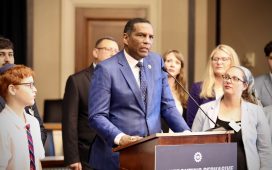Brittany Bankhead-Kendall arrived in Boston in July of 2019. Tall and trim, with straight, blond hair, bright-blue eyes, and an easy smile, she has a sunny disposition and the hint of a Texas drawl. She had just finished a general-surgery residency in Texas, and, at Massachusetts General Hospital, she would complete her training as a trauma and critical-care surgeon. As summer eased into fall, she struggled to acclimate to the weather. At the hospital, she operated on patients who’d suffered serious injuries—people hurt in car accidents or house fires, or by gunshots. Patients would arrive with fractured skulls and ruptured spleens, collapsed lungs and bleeding bowels. Bankhead-Kendall got good with gore.
In March, 2020, as the coronavirus descended on Boston, she learned that her role would evolve. She would be stationed in the I.C.U., where the sickest COVID-19 patients would be treated, and start working primarily as a physician, not a surgeon. Bankhead-Kendall read with care the flurry of hospital-wide e-mails detailing new procedures and protocols: where patients would be isolated, how P.P.E. would be rationed, when additional staff would be called in. Keeping track of new information felt like a full-time job. Still, at first, the surge didn’t materialize. “There was just this impending sense of doom,” she told me recently, over Zoom. “Then, all of a sudden, it was at our doorstep.”
The first COVID-19 patient she cared for was a woman in her mid-thirties. (Some details have been changed to protect patient privacy.) The woman was admitted to a step-down unit—the rung between an I.C.U. and a general-medicine floor—and, though previously healthy, she now needed concentrated oxygen delivered through a nasal tube to insure safe levels in her blood. Bankhead-Kendall’s shifts began in the evenings. When she arrived, she’d stop by the patient’s room. She’d watch her breathing through a window, record her vital signs, review her blood tests, and consider whether and when she should intubate her. For a few days, the woman was the only COVID-19 patient in the hospital.
Then things accelerated. One patient became three, three became ten, ten became thirty—an overwhelming deluge of COVID-19 patients. Her nightly rounds transformed into an escalating struggle. “We just tried to stay afloat,” Bankhead-Kendall said. “It was pure survival mode.” She was tapped to join the hospital’s “airway team”—a group who rushed to intubate patients when their breathing collapsed. The airway team received emergency pages and overhead alerts; when the alerts came, with alarming frequency, Bankhead-Kendall sprinted with a neon backpack full of supplies to the patient’s room, where doctors, nurses, and respiratory therapists had converged. A swift, coördinated ritual commenced. The patient could be unconscious or heaving and coughing, spraying virus everywhere. A mask connected to an oxygen bag would be placed over his nose and mouth. Someone would lower the head of the bed, another would guide a catheter into a vein (or, if that failed, drill it into a bone), and a third would administer sedative medications. Yet another doctor—sometimes Bankhead-Kendall—would peer down the patient’s throat, spy the vocal cords, and insert a plastic tube, while others monitored, prepared to perform C.P.R.
Bankhead-Kendall had never experienced anything like this. The number of patients needing intubation kept rising; often, she was startled by the speed with which their breathing declined. Debates erupted over whether the team should start intubating patients sooner, to prevent the chaos of doing it in a rush later, or continue waiting, to give patients a chance to recover without ventilators. These questions were further complicated by a constant fear of infection. Doctors were still learning about how they might keep themselves safe; intubation was already seen as among the riskiest of medical procedures. Bankhead-Kendall, who has asthma and regularly uses an inhaler, felt especially vulnerable. “Whenever I got coughed on, it felt like a death sentence,” she said. “Every day I thought, This could be the end.” She rewrote her will and told her parents where to find her passwords and what to do if she ended up on a ventilator. She taped important documents to the inside of her apartment’s front door—if she died, and someone had to enter her home, she didn’t want them to risk getting infected.
When I started speaking with Bankhead-Kendall this spring, a year had elapsed since the start of the pandemic. She had begun to emerge, shaken, from the most physically and emotionally taxing experience of her life. As a physician myself, who had also treated large numbers of COVID-19 patients at a big-city hospital, I was trying to understand what the pandemic’s stresses had done to health-care workers and their families. Clinicians have suffered extraordinary levels of mental distress during the pandemic; many have reported anxiety, depression, suicidal thoughts, and symptoms of post-traumatic stress disorder. According to some estimates, more than three thousand health-care workers have died after being infected by the virus. Today, thanks to vaccines, the medical crisis of the pandemic is starting to wane. And yet its mental-health consequences will linger, for patients and doctors. For Bankhead-Kendall, as for many other clinicians, this has been a long year of fear, despair, isolation, and tenuous resilience.
In Boston, last year, February turned to March, and the winter deepened. Days of viral surge became weeks. Bankhead-Kendall started to feel the weight of the never-ending intubations. She was often charged with calling families to discuss the procedure, and she found that people viewed it with horror. “Being part of the intubation team meant being a person that patients and families saw as a ticket to death,” she told me. “I went into medicine to help people—now I was someone they feared.” Despite her exhaustion, she started to have trouble sleeping. When she did fall asleep, she was jolted awake by nightmares. She saw huge masses of sick people, coughing, bleeding, gasping for air. She watched as they approached the hospital and burst through the doors of the emergency department, crying for help. She saw herself standing alone—stunned, angry, confused—choosing who would live and who would die.
Bankhead-Kendall was born and raised in West Texas. The eldest of three daughters, she was determined and ambitious. Her father was a petroleum engineer and her mother a teacher, but she knew from an early age that she would be a doctor. One day, in middle school, she rushed home beaming, carrying a small object wrapped in Kleenex; inside was a sheep’s eye. She told her mother, “I was the only one in class who cut it out without tearing anything.” When she was in the seventh grade, her family relocated to Argentina; within weeks, she decided to run for class president. “I said, ‘Brittany, no one knows you here! Are you sure?’ ” her mother, Athena Bankhead, told me recently. “She didn’t win, but after her speech everyone knew who she was. She was never afraid to put herself out there.”
The family soon moved back to Texas. Bankhead-Kendall attended college at Texas A. & M., where, during her senior year, she met her future husband, Brian Kendall, in a medical-communications class. After graduation, she moved to Miami to start a master’s program in biomedical sciences; Brian entered the Peace Corps and worked in Albania as a health-education volunteer, then joined Brittany in Miami. They became active in a local church and, to make ends meet, picked up shifts at a nearby golf course (he worked as a bag boy, she drove a beverage cart); they used their tip money to buy health insurance. In 2008, they married. They applied to medical school together, while on their honeymoon, in Bali. They had a son, Knox, while in medical school, and a daughter, Tinsley, six years later, during their residencies.
In 2019, the family moved into a two-bedroom apartment in Cambridge, Massachusetts, near the Longfellow Bridge, just across the Charles River from Boston. Brittany started her fellowship in surgical critical care, and Brian worked as an E.R. physician at two community hospitals north of the city. In March, as coronavirus cases surged across the Northeast, they began spending nearly all their time at their hospitals. Brittany was working a string of fourteen-hour overnight shifts when Boston’s schools closed. Between shifts, unable to sleep, she lay in bed reading the Internet: one browser tab contained lesson plans for her son, another emerging evidence on how to treat COVID-19. She began to have a terrible feeling that, during the pandemic, it would be impossible for her to be a good parent and a good doctor simultaneously.
On a frigid Sunday in mid-March, she started a twenty-four-hour shift in the I.C.U. A little after midnight, she intubated a patient; at around 2 A.M., she was paged to the bedside of a woman who was deathly ill with the coronavirus. In recent days, Bankhead-Kendall’s worst fears had started materializing. The I.C.U.s were full of coronavirus patients for whom little could be done; she and others were constantly racing around the hospital, intubating patients whose breathing had collapsed—and each day more people flooded the emergency room, wheezing, heaving, in various states of consciousness. At the bedside, she felt a sudden, overpowering urge to get her children to safety. From a cot in the trainee workroom, she called her parents, Athena and Dale, in Texas.
“Everyone is dying,” Brittany said to her mother. “They’re talking about shutting down the country.” As the sun rose, she drove home to gather her children. “We’re going to see Honey and Bear,” she told them.
On the plane to Dallas, she was among the few passengers wearing a mask; she disinfected the seats vigorously with wipes, enduring quizzical glances. Travel had already started to slow, and the Dallas terminal felt eerily quiet under its fluorescent lights. Athena and Dale met Brittany and the kids near baggage claim. The children ran to greet their grandparents. Brittany stood alone at the carousel, where a suitcase made the rounds. She flinched when her father walked over and tried to hug her.
“Dad, you have to stay away,” she said.
Dale and Athena took Knox and Tinsley into one of the airport’s family restrooms, removed their clothes, and scrubbed their bodies with wipes. They dressed their grandchildren in pajamas and put their travel clothes in a separate bag. When their daughter came into the room, to retrieve something from the kids’ luggage, she looked dazed. “She had no emotion,” Athena recalled. “She was so matter-of-fact. I could tell she was compartmentalizing. It was just ‘This is the task at hand. This is what I need to do.’ ”
Out in the terminal, Bankhead-Kendall waved goodbye from a distance and turned to walk to her gate. She knew that some doctors had been killed by the coronavirus; as she boarded the flight back to Boston, she didn’t know whether she would see her children again.
In normal times, some ten to twenty per cent of patients admitted to an I.C.U. go on to die. In the spring of 2020, the COVID-19 mortality rate for patients requiring I.C.U.-level care approached fifty per cent. For Bankhead-Kendall, the carnage felt suffocating and endless; it was aggravated by the cruel fact that most patients died alone. Each day, orderlies brought metal gurneys to the I.C.U. to carry the bodies out. They sometimes hesitated, double-checking to make sure that they’d come to the right room—there had been so many deaths that it was hard to keep track. Months later, the sight of a gurney would trigger paralyzing flashbacks for Bankhead-Kendall. At the time, they mainly made her feel inept. “Nothing I did ever felt like it was enough,” she said. “We were supposed to be good at getting people better. Instead, we got good at dealing with dead bodies.”
These feelings of inadequacy were exacerbated by the uncertainties of treating COVID-19. Often, medical professionals had to draw on speculation and anecdotes in making clinical decisions. “It was, like, ‘We’re going to drop you off in enemy territory, but we don’t actually know how to fight them, so, good luck!’ ” Bankhead-Kendall said. She joined a WhatsApp group in which physicians from around the world—China, Italy, France—shared their clinical experiences. She scrolled through increasingly ominous messages: F.Y.I., we’re seeing random bowel perforations when people are really sick; F.Y.I., we’re seeing fatal arrhythmias after patients get better.
On Easter Sunday, she worked another overnight shift. Among her patients was a woman in her fifties who was experiencing many of the most serious COVID-19 complications: blood clots, heart damage, kidney failure. She’d been on a ventilator for weeks, and there was little indication that she would recover; her family had decided that prolonging her life would only prolong her suffering. It fell to Bankhead-Kendall to call the woman’s husband and discuss the process for withdrawing care. The man told her that he himself had chronic medical problems and couldn’t come in. Bankhead-Kendall promised him that she would stay with his wife after the breathing tube was removed.
In the evening hours, the woman faded in and out of consciousness, and Bankhead-Kendall held her hand. She spoke aloud the names of her family members, and told her that they loved her. She took out her phone, opened the Pandora app, selected a Frank Sinatra station, and placed it in a ziplock bag near her head.
She looked through the window, into the hall. Outside the room, nurses held up signs containing lab results for other critically ill patients and queries about their ventilator settings. Bankhead-Kendall mimed answers to their queries.
Around midnight, the woman’s heart rate became erratic and slow. Bankhead-Kendall listened as, through the phone’s speakers, “Over the Rainbow” started to play. The woman’s heart stopped; she took her last breath. Bankhead-Kendall turned to look at the clock and pronounce the time of death.
After sending their kids to Texas, Brittany and Brian told their colleagues that they could pick up more shifts. If they were going to be apart from their children, they wanted to make the most of it. They’d hoped that the separation would last a few weeks, but, as the weather warmed, it became clear that a reunion was far off. The surge was unrelenting—hospitals were so full that patients were sometimes treated on stretchers in hallways. After a long shift on her birthday, in late April, Bankhead-Kendall came home and propped her phone up against a bowl of avocados on the kitchen island; as the kids watched over FaceTime, she blew out some candles. As a trainee, Brittany had less control over her time than Brian did. In the time that she did have off, she had trouble disengaging. Brian noticed her mood darken. “She would come home and tell me these horrific stories, day after day,” he recalled. “I’d try to pull her back a bit. I’d say, ‘You have to maintain some sort of boundary. There’s such a thing as being too invested.’ ”
In Texas, on a chalkboard on his grandparents’ refrigerator, Knox started keeping a tally of the number of days since he’d seen his parents. On some evenings, he and Brian would play Battleship over FaceTime and chat about the day’s activities, which for Knox might have included a hike, a picnic, or a bike ride. Occasionally, Brittany’s sisters would stop by with their kids, so that Knox and Tinsley could play with other children. Knox missed his parents, but mostly managed. Tinsley, who was two, had a harder time. She was confused by the separation. She grew withdrawn and angry; she started having more tantrums. When Brittany and Brian read to her over FaceTime, she would push the phone away; after they’d hung up, she would ask for them. One day, when Athena was changing Tinsley’s diaper, the girl saw a photo of her parents on a nearby wall. “She just started wailing and wailing,” Athena said. “It was devastating. I thought, No baby should have to be away from her parents like this. It’s not right. But what choice did we have?”
In June, in Boston, the pace began to slow. Infections fell across the Northeast, and some of the makeshift I.C.U.s at Mass General were dismantled. But Bankhead-Kendall was still seeing COVID-19 patients, and her nightmares continued. In dreams, she sprinted toward their rooms only to arrive too late; she stared at them through windows as they gasped for air over the sounds of alarms and ventilators. She saw herself separated from her children forever. One afternoon, after rounds, while finishing her notes in a workroom, she started to cough—a guttural, productive cough that wouldn’t stop. She gathered her things, rushed to the employee clinic, and got tested for the coronavirus. The test ultimately came back negative, but she still had to self-isolate.
That would be her last shift in Boston: by the time she was out of quarantine, her fellowship—a one-year program, beginning and ending in July—was over. The previous year, she’d accepted a faculty position at Texas Tech University, in Lubbock; Brian had moved there in May, to start his own faculty job and work as an emergency-room physician. Now Brittany packed up the last of their things and followed. When she landed in Lubbock, Knox raced across the terminal and jumped into her arms. Tinsley, however, held back. “As a mom, it was heartbreaking,” Bankhead-Kendall told me. “It felt like she’d forgotten who I was.” As they walked through the airport, Tinsley started talking. “I realized how much she’d changed,” Bankhead-Kendall said. “I realized how much I’d missed.”
In Lubbock, the coronavirus case rate was lower, and the hospital ran more or less normally. Bankhead-Kendall returned to the operating room. The work was intense: during a typical shift, she might see thirty new patients and operate on five or ten. Most of her patients had suffered serious physical trauma—a motorcycle accident, a gunshot wound; previously healthy, they depended on emergency surgery to survive. “That’s my jam,” Bankhead-Kendall said. “I was riding high.” When she had a spare moment, she would pop down to see Brian in the emergency department.







